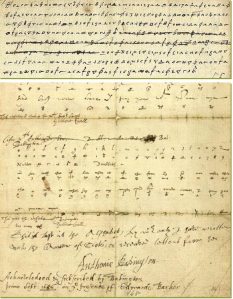For thousands of years Kings, Queens, Emperors, and their spies have been writing their important communications in code. In the days before telephones, emails, and text messages, it was the only way of keeping important messages private. Napoleon’s spies were excellent code writers AND code breakers. George Washington sent messages to his many secret agents in code. In 1586, Mary, Queen of Scots, was caught and punished for attempting to overthrow the English Queen, Elizabeth I, after her secret correspondence was intercepted and decoded by an English spy. Julius Caesar, emperor of Rome, encrypted all of his important military messages with a code that is known to this day as a Caesar Code.

The process of writing a message in a code is called “encrypting”. Decoding the message so that it is readable again is called “decrypting”. In order for you to encrypt the message and for someone else to decrypt the message, you both need to use the same code. That code is called a “cipher”. There are many types of ciphers you can use, but we’ll start with a Caesar Cipher, which is a simple substitution cipher that uses the alphabet.
A substitution cipher means that we are substituting one letter for another. It’s really quite simple. Here’s how to do it!
Write down the letters A through M in a neat row.
Then, directly below the line of letters you just wrote, write the letters N through Z, making sure that you line up each letter below the one above. For example, the N must be right underneath the A, the O under the B, the P under the C, and so on.
Your cipher will look like this:

Then, when you code a message, you will substitute the correct letter in your word for the letter above or below it in the code. Using the code above, the word HELLO would be encoded to URYYB. The word SPY would be encoded to FCL.

Can you decode this word? FRPEGT
Now comes the fun part! It’s time to create your own message. Simply write out your message on a piece of paper. Using the code you made, substitute your letters for the code letters. When you pass your coded message to the person who is supposed to read it, then you have to make sure you tell them how to write out the cipher so that they can decode your message. But be careful – don’t let anyone else know the cipher!
Want a bigger challenge? Then check out the CIA’s website for spy kids. There are many great cipher or secret code challenges that will test your ability as a code breaker. Our Spy Science Secret Message Kit has several ways for you to encode your messages. From Secret x-ray paper, to morse code, and to invisible ink – you’ll have plenty of fun choices for your next secret message.
The book, Codes, Ciphers and Secret Writings starts with a simple substitution cipher and builds to more complex codes so that you can understand exactly how it’s done. There are practice messages included so that you can practice your newly acquired skills. Now that you know the basics, you can try your hand at creating your very own code. You can use numbers, pictures, symbols, shapes, and letters. Remember though, make sure to: Xrrc lbhe pbqr n frperg!
